Homemade Thai Papaya Salad: How To Make It At Home
Homemade Thai Papaya Salad isn’t just a dish it’s an experience. The first bite takes you straight to the bustling streets of Bangkok, where the air is alive with the aromas of garlic, chilies, lime, and roasted peanuts. At JustThaiRecipes, we believe food has a story, and so does this blog. On our About page, Lina shares how she and her partner created this space to bring authentic Thai flavors into kitchens around the world. Their mission is simple yet powerful: help home cooks discover, master, and fall in love with Thai cuisine. From classic street food to comfort meals, their recipes are inspired by the vibrant energy of Thailand.
In this ultimate guide, we’ll explore everything about Homemade Thai Papaya Salad, also known as Som Tum. You’ll learn what makes it unique, its health benefits, key ingredients, and how to make it step by step with tips straight from Thai kitchens. Whether you’re a seasoned Thai food lover or trying it for the first time, this article will give you all you need to make a perfect bowl at home.
Table of Contents
Table of Contents
Understanding Homemade Thai Papaya Salad
What Makes Homemade Thai Papaya Salad Unique?
At its core, Homemade Thai Papaya Salad is a beautiful balance of four essential Thai flavors: sweet, sour, salty, and spicy. Imagine crisp green papaya strips tossed with garlic, fiery chilies, tangy lime juice, earthy fish sauce, and crunchy roasted peanuts. Every bite of Homemade Thai Papaya Salad is refreshing yet explosive with flavor. This salad isn’t just a side dish; in Thailand, it’s often a meal in itself, served with sticky rice and grilled chicken.
But what makes Homemade Thai Papaya Salad stand out from other salads? It’s the pound-and-flip technique used in its preparation. Instead of mixing ingredients with a spoon, Thai cooks use a mortar and pestle to gently bruise the papaya and combine flavors. This method helps release aromatic oils from chilies and garlic, giving Homemade Thai Papaya Salad its signature boldness and depth of flavor.
The History and Cultural Roots of Som Tum
Did you know Homemade Thai Papaya Salad originated in Northeastern Thailand? This region, known as Isaan, shares culinary traditions with neighboring Laos, where a similar dish called Tam Mak Hoong is equally popular. While Lao papaya salad tends to have a stronger fermented fish sauce flavor, Thai Som Tum leans more toward sweetness and citrusy notes.
In Thai culture, Som Tum is more than food; it’s a communal experience. Street vendors pound it fresh to order, tailoring spice levels to your preference. Families enjoy it together with sticky rice, grilled meats, and fresh vegetables on the side. It represents the spirit of Thai dining—vibrant, interactive, and joyfully shared.
If you’ve never tried making it at home, you’re in for a treat. It’s surprisingly easy, requiring only a few fresh ingredients and a mortar and pestle to get started.
Health Benefits of Homemade Thai Papaya Salad
Is Thai Papaya Salad Healthy for You?
Absolutely. Homemade Thai Papaya Salad is a powerhouse of nutrition disguised as a flavorful dish. Green papaya, the star ingredient, is low in calories yet packed with essential vitamins and enzymes. It’s rich in vitamin C and antioxidants that help fight inflammation and support your immune system. The natural enzymes in green papaya, like papain, are excellent for digestion, making this salad a go-to for gut health.
The beauty of Som Tum lies in its minimal use of oil and its abundance of fresh ingredients. Unlike heavy Western salads loaded with creamy dressings, Thai papaya salad gets its flavor from lime juice, fish sauce, and a touch of palm sugar. These ingredients keep it light and refreshing.
For anyone watching their weight, this salad offers a satisfying crunch and bold taste without unnecessary calories. A typical serving contains less than 150 calories, depending on portion size and dressing.
Nutritional Breakdown of Homemade Thai Papaya Salad
| Ingredient | Key Benefit | Calories (per serving) |
|---|---|---|
| Green Papaya | High in fiber, aids digestion | 30 |
| Garlic | Boosts immunity, reduces cholesterol | 5 |
| Thai Chilies | Increases metabolism, rich in Vitamin C | 2 |
| Palm Sugar | Natural sweetener with trace minerals | 15 |
| Fish Sauce | Source of protein and essential minerals | 10 |
| Tamarind Paste | High in antioxidants | 8 |
| Roasted Peanuts | Healthy fats, protein, and fiber | 50 |
| Lime Juice | Vitamin C for immune support | 8 |
This makes Homemade Thai Papaya Salad a perfect option for a nutritious lunch or dinner side dish. It’s especially ideal for anyone seeking a low-carb, gluten-free, or dairy-free meal.
Why You Should Include It in Your Weekly Menu
Adding this salad to your routine is a smart way to enjoy healthy eating without feeling restricted. The variety of textures—crunchy papaya, tender tomatoes, and crisp long beans—keep your taste buds engaged, while the spicy kick helps control appetite naturally.
Discover great ideas like Thai Mango Sticky Rice if you’re looking for a healthy dessert pairing after your meal.
Ingredients You Need for Easy Homemade Thai Papaya Salad
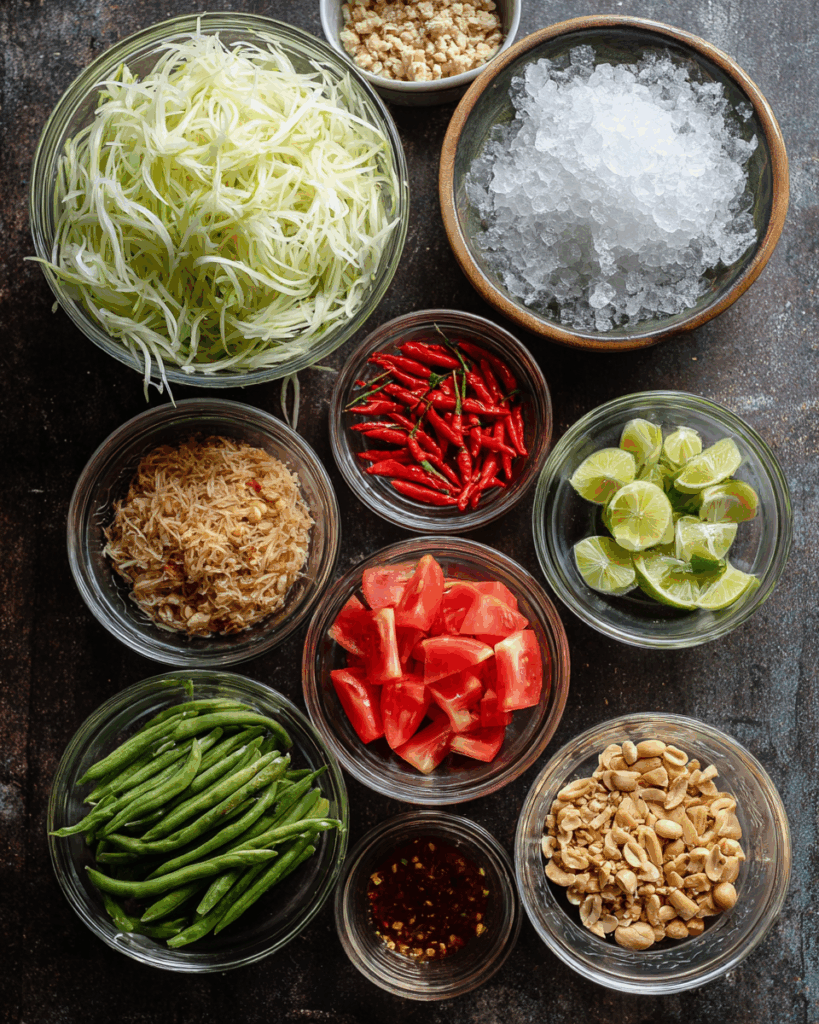
Thai Papaya Salad Ingredients Checklist
To achieve an authentic flavor, you’ll need:
- 1 ½ cups julienned green papaya (soaked in ice water for 10-15 minutes to firm up)
- 2 cloves garlic (for depth and aroma)
- Thai chilies to taste (for heat—adjust based on your spice tolerance)
- 1 ½ tablespoons palm sugar, finely chopped and packed
- 2-3 long beans, cut into 2-inch pieces
- 3 tablespoons roasted peanuts (adds crunch and nuttiness)
- 1 heaping tablespoon small dried shrimp (roughly chopped if large)
- 2 tablespoons fresh lime juice
- 2 teaspoons tamarind paste
- 1 ½ tablespoons fish sauce
- ½ cup grape tomato halves or small tomato wedges
Finding Fresh Green Papaya and Ingredient Substitutes
Green papaya is the most crucial ingredient. It’s available in most Asian grocery stores, but if you can’t find it, you can substitute with shredded carrots or cucumbers for a Thai papaya salad vegetarian version. Similarly, replace fish sauce with soy sauce to make the recipe vegan-friendly.
Why Ingredient Quality Matters
Using fresh, high-quality ingredients makes all the difference. Opt for freshly squeezed lime juice instead of bottled and choose palm sugar over white sugar for authentic depth of sweetness.
Check out Thai Mango Salad for another vibrant Thai salad recipe featuring tropical flavors.
Step-by-Step Instructions for Making Thai Papaya Salad
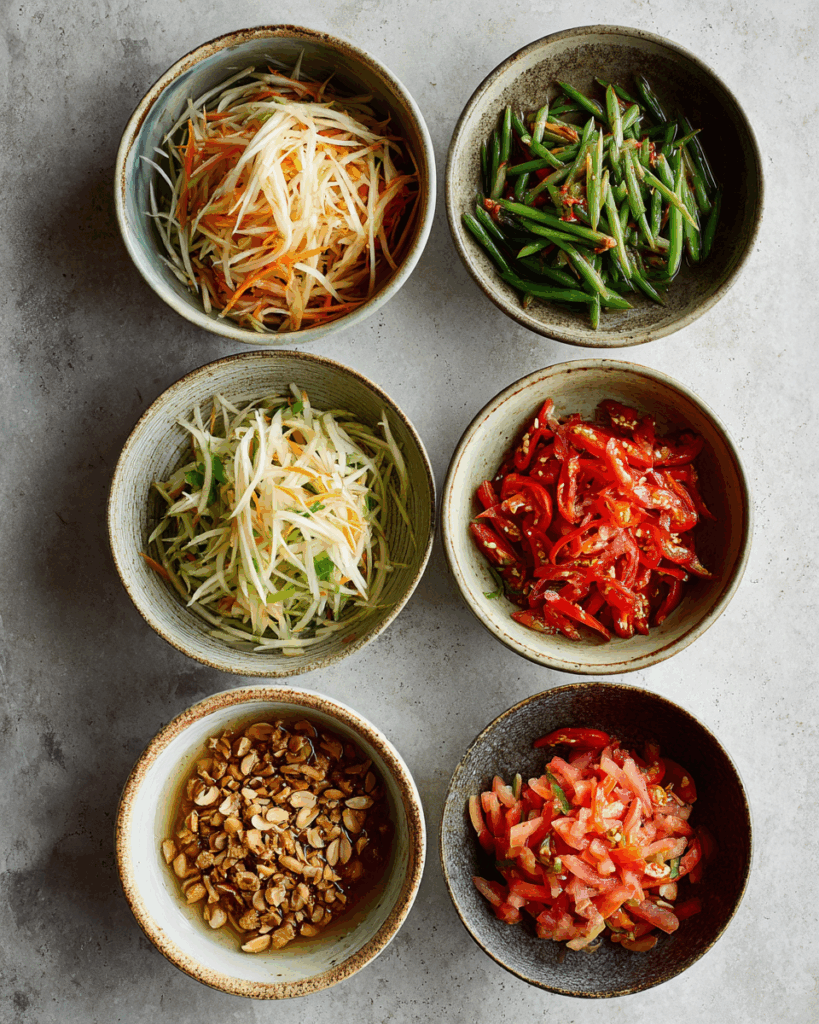
Prepping Your Ingredients Like a Pro
The secret to a truly delicious Homemade Thai Papaya Salad starts with how you prepare your ingredients. After soaking the shredded green papaya in ice water for 10–15 minutes, drain it thoroughly. This step ensures a firmer texture and prevents excess water from diluting the vibrant dressing.
Meanwhile, gather your garlic, chilies, palm sugar, and other ingredients. Having everything ready at hand speeds up the process and helps you focus on the key pounding technique.
Pounding and Mixing: The Traditional Method
- Pound garlic and chilies in a mortar and pestle until no large chunks remain. Tiny bits of chili skin are fine and add texture.
- Add palm sugar and mash until it forms a wet paste. Make sure all lumps are fully dissolved.
- Toss in long beans and pound lightly to bruise them. This helps release their fresh, grassy aroma.
- Stir in dried shrimp and roasted peanuts. Pound gently to break up the peanuts slightly.
- Add fish sauce, tamarind paste, and lime juice. Drop the squeezed lime halves into the mortar to infuse extra citrus fragrance.
- Combine with shredded papaya and grape tomatoes. Use the pound-and-flip technique (gently pounding while flipping with a spoon) until all ingredients are well mixed and the tomatoes are slightly crushed.
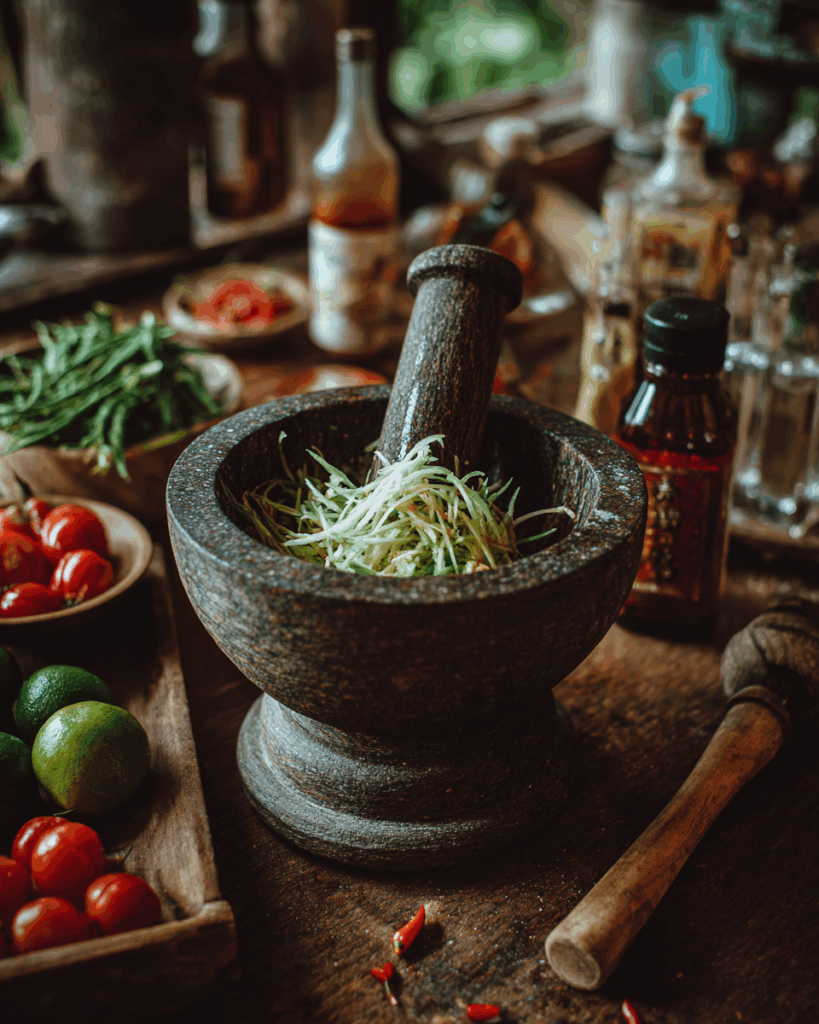
Serving Suggestions to Elevate Your Thai Meal
Serve immediately for the freshest taste. Sprinkle with extra peanuts and pair with sticky rice and BBQ chicken for a complete Thai experience.
For a visual guide, check out this detailed tutorial from RecipeTin Eats on Green Papaya Salad. It offers stunning step-by-step photos to guide you through every stage.
You can also see variations of this recipe at Maangchi’s Som Tam Recipe and a modern twist on The Woks of Life Thai Green Papaya Salad.
Common Questions About Thai Papaya Salad
Why Is Thai Papaya Salad So Spicy?
Thai food embraces bold heat, and Som Tum is no exception. Thai bird’s eye chilies deliver intense spiciness balanced by the sweetness of palm sugar and tangy lime. You can adjust the heat level by using fewer chilies or removing their seeds before pounding.
What Is a Thai Papaya Salad Called?
In Thailand, this dish is called Som Tum—literally “pounded sour.” The name reflects the preparation method (pounding in a mortar) and the tangy flavor profile.
What’s the Difference Between Thai and Lao Papaya Salad?
Though similar, Thai Som Tum and Lao Tam Mak Hoong have key differences:
- Thai version: Sweeter and tangier with fresh lime juice and palm sugar.
- Lao version: More pungent with fermented fish sauce (padek) and often spicier.
Want to explore further? Learn more about Thai Mango Salad for another refreshing salad option.
Variations of Homemade Thai Papaya Salad
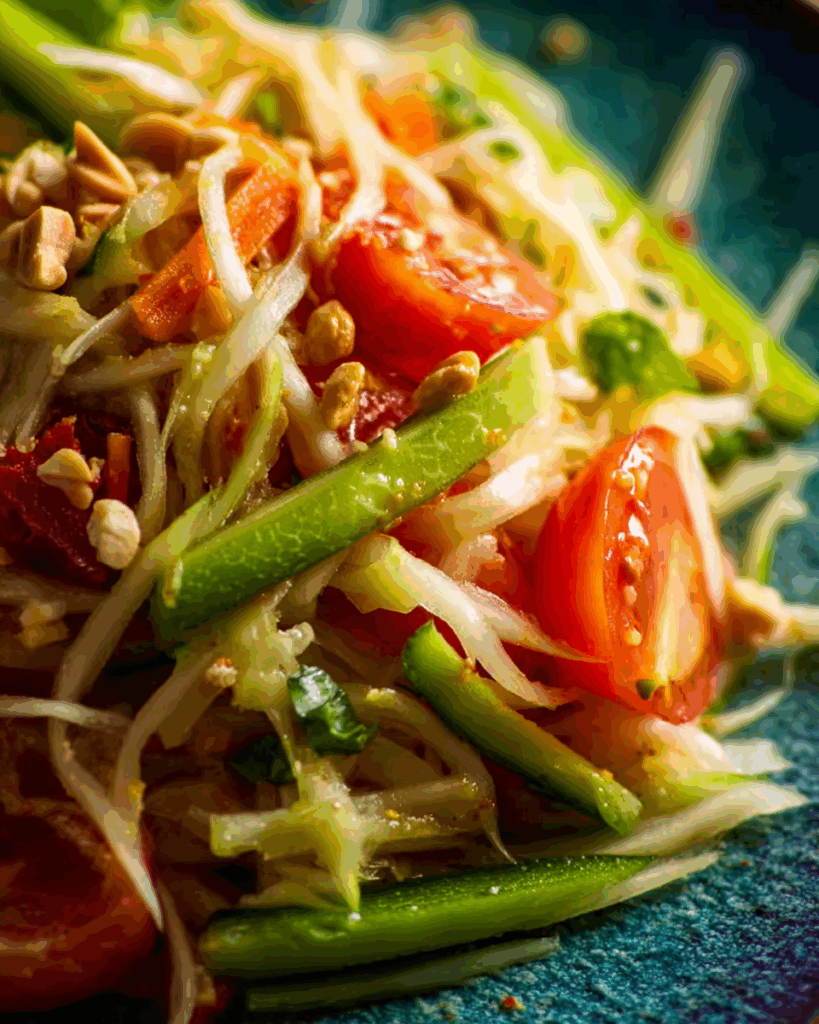
Homemade Thai Papaya Salad, or Som Tum, is a wonderfully adaptable dish. While the classic recipe is beloved for its crunchy green papaya and fiery dressing, Thai cooks across regions and even home chefs worldwide have developed delicious variations. Whether you’re vegan, seeking more protein, or craving something exotic, there’s a version of Som Tum for everyone.
1. Traditional Thai Variations
Som Tum Thai (Sweet and Tangy Style)
This is the most popular version of papaya salad in Central Thailand. It balances sweetness from palm sugar, tartness from lime juice, and savory fish sauce. Roasted peanuts and dried shrimp give it a satisfying crunch and umami depth.
Som Tum Poo (With Pickled Crab)
A bolder version from Isaan (Northeastern Thailand), Som Tum Poo includes fermented crab for an intense salty-sour kick. Not for the faint of heart but a favorite among locals who love strong flavors.
Som Tum Pla Ra (With Fermented Fish Sauce)
This Lao-influenced variation replaces regular fish sauce with pla ra (fermented fish sauce). It gives a pungent aroma and robust umami that hardcore papaya salad fans swear by.
2. Vegetarian and Vegan Variations
Thai Papaya Salad Vegetarian
For a vegetarian twist, replace fish sauce with soy sauce or mushroom sauce and skip dried shrimp. This keeps all the freshness and crunch without any animal products.
Thai Papaya Salad Vegan
To make it fully vegan, also ensure your sugar is vegan-certified (some palm sugars are processed with animal bone char). Add toasted sesame seeds or crushed cashews for protein and texture.
3. Fruit-Based Variations for a Sweet Twist
Mango Papaya Salad
Swap green papaya with julienned green mango for a tangier and slightly fruitier flavor. The natural sourness of mango pairs beautifully with the spicy dressing. This variation is perfect for summer.
Explore Mango Papaya Salad inspiration here.
Apple Papaya Salad
For a Western-friendly option, replace papaya with firm green apples (like Granny Smith). The tartness of apple provides a refreshing contrast to the dressing.
Carrot Papaya Salad
Julienned carrots make an excellent alternative for a colorful, nutrient-packed salad. This version is kid-friendly and works well for meal prep.
4. Protein-Packed Papaya Salad Variations
Papaya Salad with Grilled Shrimp
Adding grilled shrimp transforms this salad into a light yet protein-rich main course. Simply toss in warm, juicy shrimp at the end for extra flavor.
Papaya Salad with Grilled Chicken
Pair Som Tum with thinly sliced Thai grilled chicken for a classic street food combination. The smoky chicken balances the spicy-sour salad beautifully.
Check out Coconut Mango Chicken Curry for another protein-packed Thai recipe.
Papaya Salad with Crispy Tofu (Vegan)
Crispy pan-fried tofu cubes add a satisfying bite for vegan and vegetarian eaters. Toss them gently with the salad just before serving to keep the texture crisp.
5. Global Fusion Papaya Salad Variations
Thai-Mexican Papaya Salad
Add avocado cubes, roasted corn, and a dash of smoked paprika for a Thai-Mexican fusion salad. A drizzle of lime crema makes it irresistible.
Mediterranean Papaya Salad
Toss in crumbled feta, Kalamata olives, and fresh mint for a Mediterranean twist. Replace fish sauce with a squeeze of lemon juice and a touch of olive oil.
Japanese-Style Papaya Salad
Incorporate a light miso dressing and sprinkle toasted sesame seeds with nori strips for a Japanese-inspired variation.
Why Try These Variations?
Each variation opens up a new flavor experience while keeping the signature crunch and freshness of Som Tum. They’re ideal for:
- Dietary needs (vegan, gluten-free, low-carb)
- Seasonal produce availability
- Experimenting with fusion cuisine
Want step-by-step visuals for the traditional version? Follow Maangchi’s Som Tam tutorial for a Korean-American take on this Thai classic.
Tips for Perfect Homemade Thai Papaya Salad Dressing
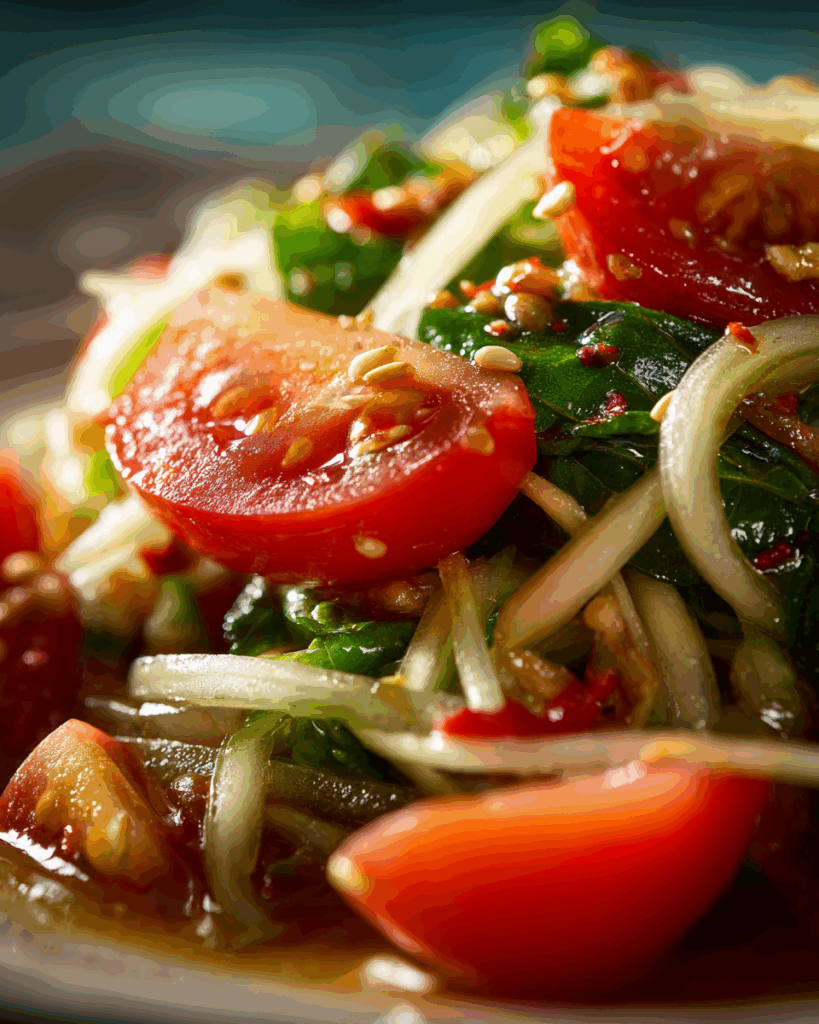
Balancing the Four Thai Flavors
The heart of any Thai dish lies in its ability to strike a perfect balance between sweet, sour, salty, and spicy. For Homemade Thai Papaya Salad, the dressing is where this magic happens. Palm sugar brings gentle sweetness, lime juice adds bright acidity, fish sauce lends deep umami saltiness, and chilies deliver that signature heat. Taste and adjust each element carefully. If your salad feels too sour, add a touch more palm sugar. Too salty? A squeeze of extra lime will round it out.
Avoid Common Mistakes
- Over-soaking the papaya – Soaking it too long can make it soggy instead of crisp. Ten minutes in ice water is enough.
- Not draining well – Excess water will dilute the dressing. Pat the papaya dry thoroughly before mixing.
- Pounding too hard – You want to bruise the papaya to absorb flavors, not mash it into a pulp. Gentle pressure is key.
- Skipping fresh ingredients – Bottled lime juice and pre-minced garlic may save time but compromise the fresh taste. Always go fresh.
How to Make Ahead and Store the Dressing
The dressing can be prepared up to 3 days in advance. Store it in an airtight jar in the refrigerator. Shake well before using, as natural separation occurs. Never mix the dressing with papaya until you’re ready to serve—this keeps the salad crisp and vibrant.
Serving and Pairing Ideas
Classic Thai Pairings
In Thailand, Som Tum is rarely served alone. It’s a central part of a larger meal, accompanied by sticky rice and grilled meats. Pair it with Thai BBQ chicken or crispy fried fish for an authentic experience. The sticky rice acts as a neutralizer for the heat and a perfect vehicle for soaking up the zesty dressing.
Modern Serving Suggestions
For a Western twist, serve Homemade Thai Papaya Salad as a starter for a summer barbecue or as a light main dish with a side of quinoa. You can also roll it into fresh spring rolls for a portable snack or appetizer.
Presentation Tips
Serve the salad in a wide, shallow bowl to showcase the vibrant colors of shredded papaya, cherry tomatoes, and chilies. Garnish with extra roasted peanuts and fresh cilantro sprigs. A lime wedge on the side adds visual appeal and invites diners to customize the acidity to their taste.
Quick Recipe Recap
Homemade Thai Papaya Salad Recipe
| Step | Details |
|---|---|
| Prep Time | 15 minutes |
| Cook Time | 0 minutes |
| Total Time | 15 minutes |
| Servings | 2-3 people |
| Main Ingredients | Green papaya, garlic, Thai chilies, fish sauce, lime |
| Equipment Needed | Mortar and pestle, sharp knife, large bowl |
Instructions Summary:
- Soak and drain shredded green papaya.
- Pound garlic and chilies, then add palm sugar and mash to paste.
- Add long beans, dried shrimp, and roasted peanuts; pound lightly.
- Stir in fish sauce, tamarind paste, and lime juice.
- Combine with papaya and tomatoes using the pound-and-flip method.
- Serve fresh with sticky rice and extra peanuts on top.
This quick recap is perfect for busy cooks who want the essentials at a glance.
Conclusion
Homemade Thai Papaya Salad is more than just a recipe; it’s an invitation to explore Thailand’s culinary artistry from the comfort of your own kitchen. With its perfect balance of spicy, sweet, sour, and salty notes, this dish offers a refreshing and nutritious option for any meal. Whether you stick to the traditional version or experiment with the many variations we’ve shared, Homemade Thai Papaya Salad will never fail to impress your taste buds and your guests.
By mastering this dish, you’re not just making a salad; you’re bringing a piece of Thai culture to your table. The crisp texture of green papaya, the aromatic blend of garlic and chilies, and the zing of fresh lime make every bite a sensory delight. So why wait? Gather your ingredients, grab your mortar and pestle, and create a Homemade Thai Papaya Salad that’s bursting with flavor and authenticity.
For a true Thai experience, pair it with sticky rice and BBQ chicken, or serve it as a light, standalone dish that showcases your cooking skills. Once you try it, Homemade Thai Papaya Salad might just become a staple in your weekly meal rotation.
FAQs
What is a Thai papaya salad called?
In Thailand, it’s known as Som Tum. The name translates to “pounded sour,” referring to the mortar-and-pestle technique used to blend flavors.
Why is Thai papaya salad so spicy?
It’s all thanks to the fiery Thai bird’s eye chilies that pack a punch. These small chilies deliver intense heat, but you can easily adjust the spiciness of Homemade Thai Papaya Salad by reducing or increasing the number of chilies.
What is the difference between Thai papaya salad and Lao papaya salad?
The main difference lies in flavor. Thai papaya salad, or Som Tum, has a sweeter, tangier profile with fresh lime juice and palm sugar. Lao papaya salad, also called Tam Mak Hoong, often includes fermented fish sauce and pickled crab for a more pungent, salty-sour taste.
Is Thai papaya salad healthy for you?
Yes, Homemade Thai Papaya Salad is one of the healthiest Thai dishes you can enjoy. With its low calorie count, high fiber content, and vitamin-rich ingredients like green papaya and lime juice, it supports digestion, boosts immunity, and provides a refreshing meal option that fits into most diets.
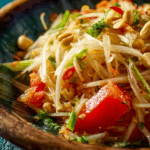
Homemade Thai Papaya Salad
- Prep Time: 20 minutes
- Cook Time: 0 minutes
- Total Time: 20 minutes
- Yield: 2–3 servings 1x
- Category: Salad
- Method: Pounded (Mortar & Pestle)
- Cuisine: Thai
- Diet: Low Calorie
Description
A vibrant Thai green papaya salad packed with fresh, spicy, sweet, and tangy flavors. This Som Tam recipe pairs beautifully with sticky rice and BBQ chicken for a classic Northeastern Thai meal.
Ingredients
- 1 ½ cups julienned green papaya, soaked in ice water for 10–15 minutes
- 2 cloves garlic
- Thai chilies, to taste
- 1 ½ tablespoon palm sugar, finely chopped, packed
- 2–3 long beans, cut into 2-inch pieces
- 3 Tbsp roasted peanuts
- 1 heaping tablespoon small dried shrimp, roughly chopped if large
- 2 tablespoon fresh lime juice
- 2 teaspoon tamarind paste
- 1 ½ tablespoon fish sauce
- ½ cup grape tomato halves or small tomato wedges
- Serving suggestion: sticky rice and BBQ chicken
Instructions
- Drain soaked papaya well and place in a bowl lined with paper towels to absorb excess water.
- In a large mortar and pestle, pound garlic and chilies until no big chunks remain.
- Add palm sugar and mash until dissolved into a wet paste.
- Add long beans and pound lightly until broken.
- Add dried shrimp and peanuts, pounding slightly to break peanuts.
- Add fish sauce, tamarind paste, lime juice, and squeezed lime skin. Stir to mix and dissolve sugar.
- Add shredded papaya and tomatoes. Mix using the pound-and-flip method until well combined and tomatoes are slightly crushed.
- Plate the salad and sprinkle with remaining peanuts.
- Serve with sticky rice and BBQ chicken for a complete meal.
Notes
- Soaking papaya in ice water helps it stay firm and crunchy.
- Adjust Thai chilies to your heat preference.
- For vegetarian version, substitute fish sauce with soy sauce or vegan fish sauce.
- Roasted peanuts can be replaced with cashews for a variation.
Nutrition
- Serving Size: 1 cup
- Calories: 110
- Sugar: 7g
- Sodium: 480mg
- Fat: 4g
- Saturated Fat: 0.5g
- Unsaturated Fat: 3.5g
- Trans Fat: 0g
- Carbohydrates: 16g
- Fiber: 3g
- Protein: 3g
- Cholesterol: 5mg
Keywords: Thai green papaya salad, Som Tam, spicy papaya salad, Thai salad recipe

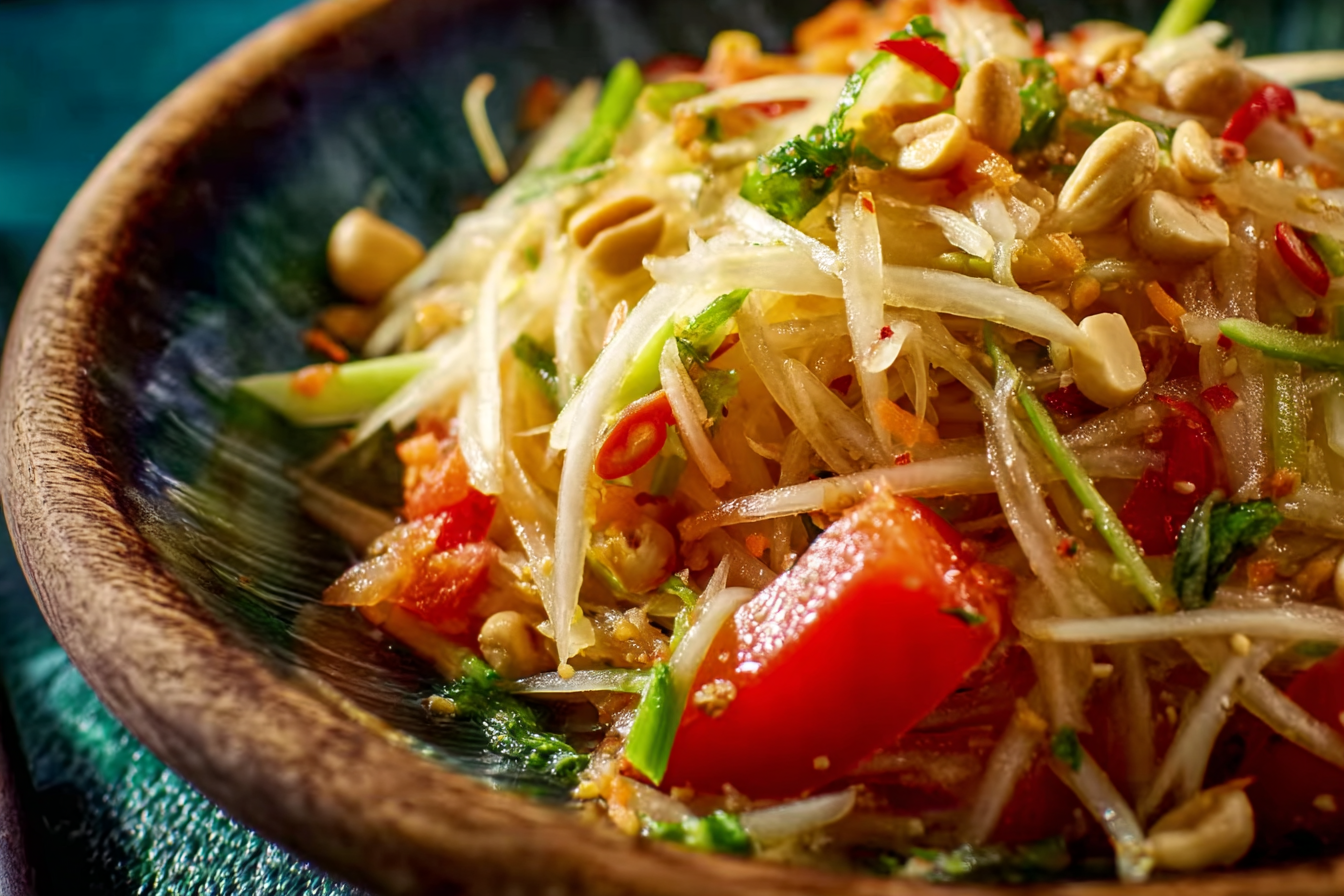
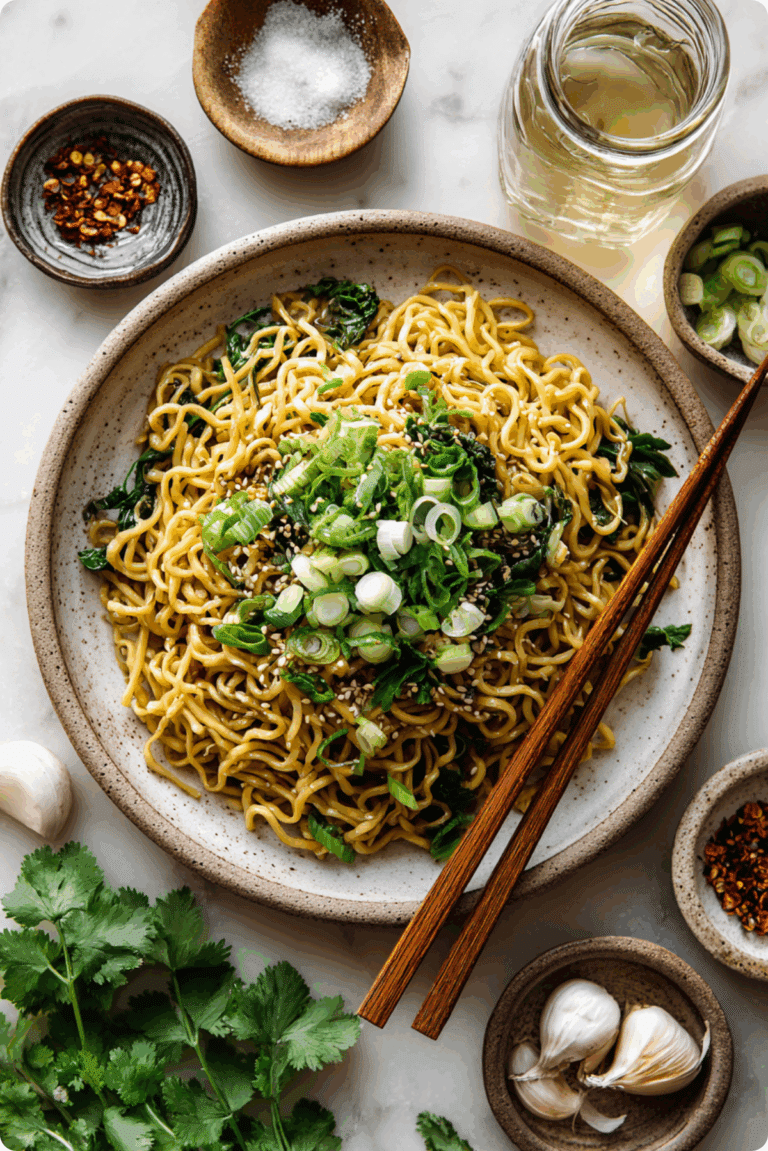
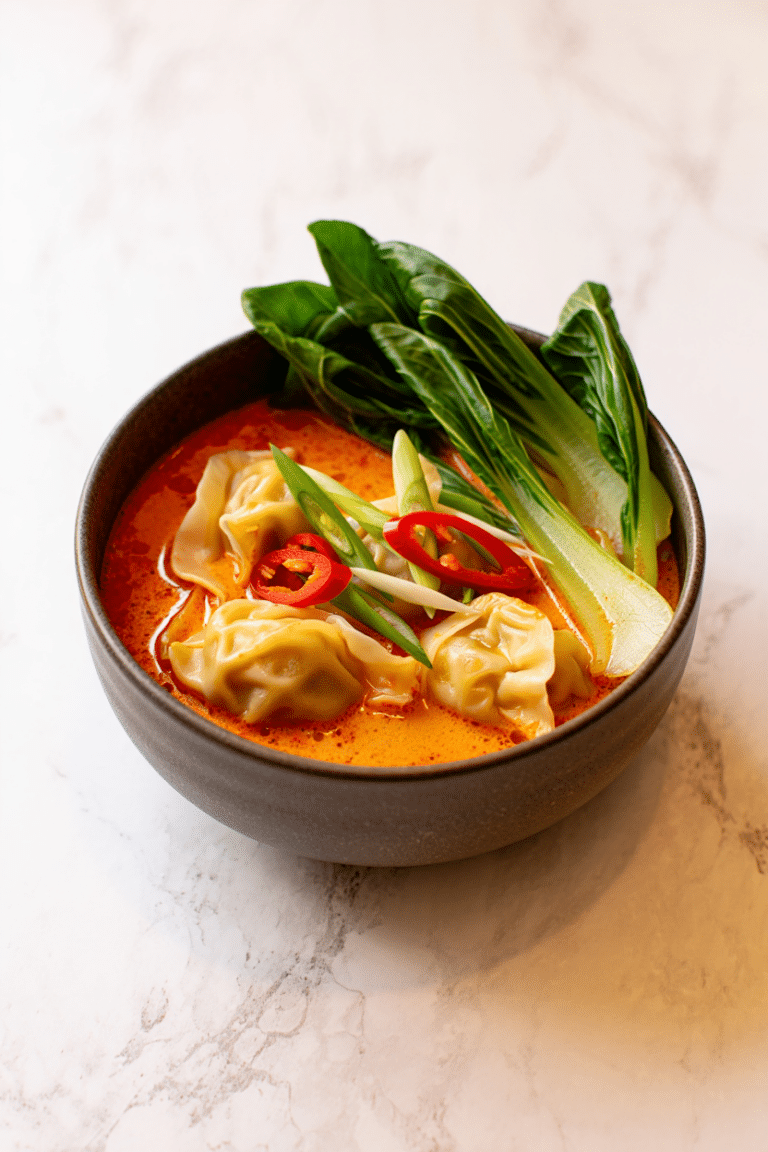
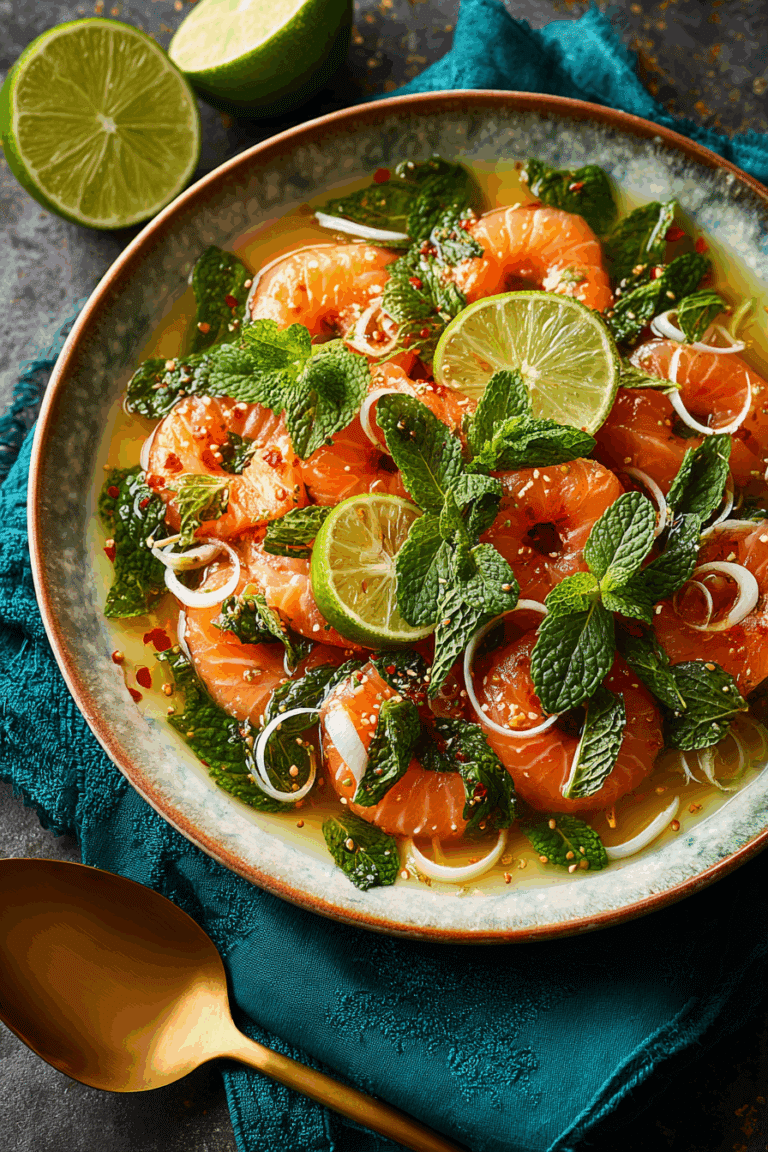
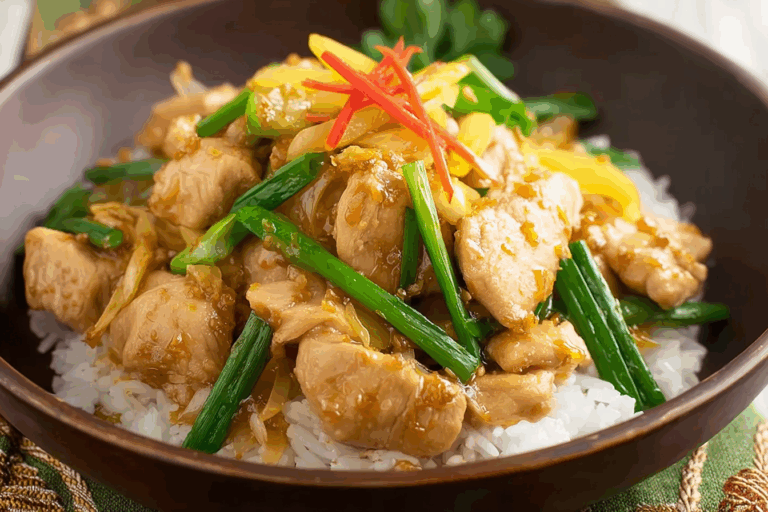
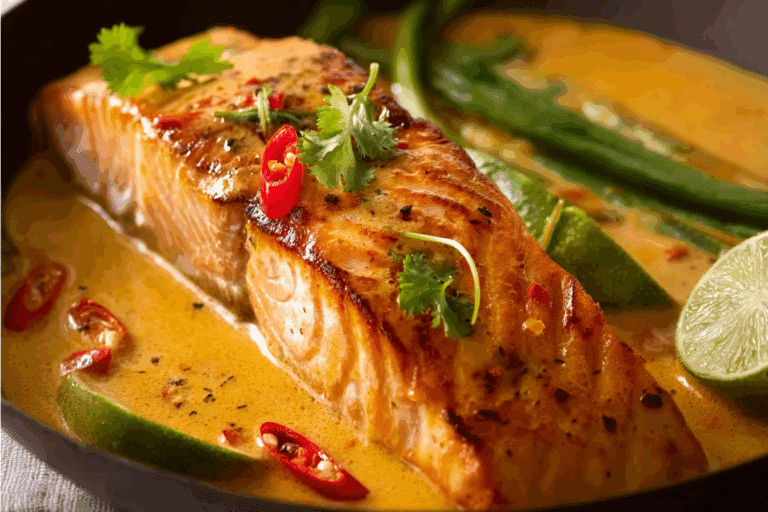
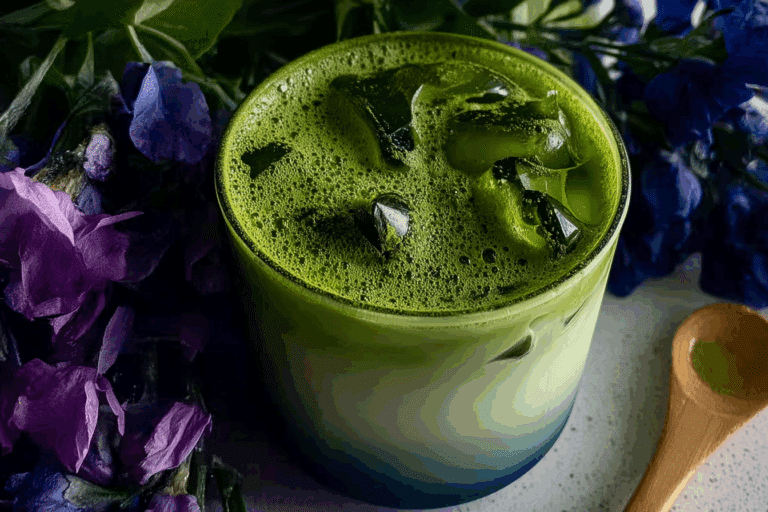
I do enjoy the manner in which you have framed this particular problem plus it does present me a lot of fodder for thought. On the other hand, coming from everything that I have personally seen, I simply trust when other opinions stack on that people remain on point and in no way get started upon a tirade associated with some other news du jour. All the same, thank you for this outstanding point and whilst I can not concur with this in totality, I respect the point of view.